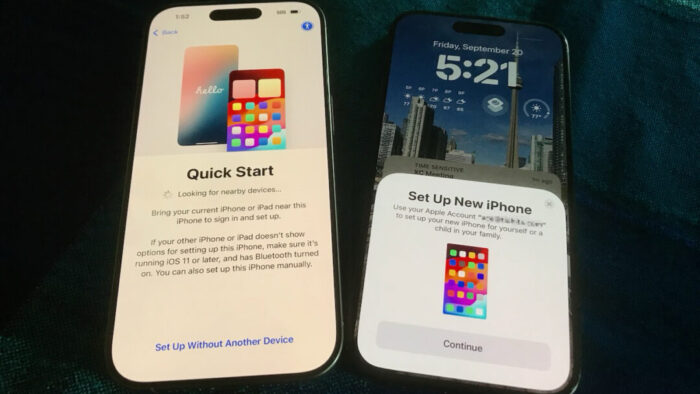If you’ve been following Apple’s recent product releases, you’ve probably heard the term “Liquid Glass.” That’s what Apple calls its newest design language, a combination of an aesthetic look and functional philosophy for the user interface in iOS 26, iPadOS 26, and macOS 26 Tahoe, in particular, but also in watchOS 26, visionOS 26, and tvOS 26 (we think of them collectively as OS 26). Apple describes Liquid Glass as a “translucent material that reflects and refracts its surroundings, while dynamically transforming to help bring greater focus to content.” The company claims that Liquid Glass “makes apps and system experiences more expressive and delightful while being instantly familiar.” Apple even has an intro video. Read More from “What’s Liquid Glass, and What to Do If You Don’t Like It”
Watch What You Say in AI-Recorded Meetings
You’re in a meeting with colleagues, and after everyone else has trickled out, you talk about a sensitive topic with a trusted friend. That would typically be no problem with an in-person meeting, but with a modern virtual meeting, where an AI records a transcript, summarizes what was said, and automatically emails it to all participants, you might not want everyone to know about your coworker conflicts, job search, health issues, relationship troubles, or countless other confidential matters. Read More from “Watch What You Say in AI-Recorded Meetings”
How to Display Contacts with Last Names First
Most people prefer Apple’s default of sorting contacts by last name, so “Andy Anderson” appears near the start of the list and “Liliana Velasco” toward the end. But some would also prefer to display contacts with their last name first, such as “Anderson, Andy,” and “Velasco, Liliana.” That’s not the default, but if it’s what you want, here’s how to accomplish it. On the iPhone and iPad, go to Settings > Apps > Contacts > Display Order and select Last, First. On the Mac, open Contacts > Settings > General and from the Show First Name controls, select Following Last Name. Read More from “How to Display Contacts with Last Names First”
When to Trust AI Tech Answers (And When to Call Us)
Recently, we’ve fielded a spate of questions from people who have used an AI chatbot to help with a technical issue and then asked us to confirm whether the information was accurate, helpful, or even safe.
First off, we’re not offended. If you can work through simple problems on your own with the help of an AI chatbot, that lets us focus on helping you with the bigger picture and issues that can be solved only by someone with awareness of your physical setup or broad knowledge of your workflow.
However, the mere fact that we’re getting these questions shows that people aren’t entirely comfortable with the AI answers, which is a good thing. Because chatbots work by giving you the most statistically likely words from their training models or extracted from search results, they can sometimes return incorrect information that could be harmful or even damaging. And, of course, they’ll do so in a breezy, confident tone that doesn’t suggest any concern. Read More from “When to Trust AI Tech Answers (And When to Call Us)”
Blood Oxygen Monitoring Returns to Recent US Apple Watches with Software Updates
With the release of iOS 18.6.1 and watchOS 11.6.1 , Apple restored blood oxygen monitoring capabilities to US Apple Watch Series 9, Series 10, and Ultra 2 models that previously had this feature disabled due to a patent infringement suit by medical device maker Masimo. Apple’s redesign processes blood oxygen data on the paired iPhone rather than on the watch itself. Read More from “Blood Oxygen Monitoring Returns to Recent US Apple Watches with Software Updates”
Keep Sensitive Data Private by Disabling AI Training Options
Most AI chatbots, including ChatGPT, Claude, and Google’s Gemini, let you control whether your conversations will be used to train future models. While allowing this could improve the AI, it also means that sensitive business information and intellectual property could become part of the chatbot’s training data. Once data is incorporated into AI training, it likely can’t be removed. Even with training disabled, you should be cautious about sharing sensitive business details, trade secrets, or proprietary code with any AI system. To reduce risks, disable these training options: Read More from “Keep Sensitive Data Private by Disabling AI Training Options”
When Should You Subscribe to AppleCare?
With Apple’s recent launch of AppleCare One, which covers multiple devices, and updates to its traditional AppleCare+ plans, you might be wondering what the best strategy is for post-warranty coverage of your Apple devices. Here’s what we suggest. Read More from “When Should You Subscribe to AppleCare?”
Follow This Advice Before Switching to a New iPhone 17
Are you considering getting one of the new iPhone 17 models? While it’s always tempting to unbox a new device and dive right in, taking a methodical approach to setup will save you from potential frustrations down the road. When you’re ready to transfer your data—and, for many people, that means much of your digital life—to the new iPhone, follow these step-by-step instructions. For visual learners, Apple provides helpful setup videos as well. Read More from “Follow This Advice Before Switching to a New iPhone 17”
Apple Unveils New iPhone 17 Lineup, Updated Apple Watches, and AirPods Pro 3
In the tech world, September brings the fruits of Apple’s harvest: new iPhones, Apple Watches, and AirPods. At its recent Awe Dropping event, Apple introduced the new iPhone 17 lineup, the ultra-thin iPhone Air, the Apple Watch SE 3, Apple Watch Series 11, Apple Watch Ultra 3, and the AirPods Pro 3. Read More from “Apple Unveils New iPhone 17 Lineup, Updated Apple Watches, and AirPods Pro 3”
Pay for Apple TV+ Annually to Avoid the Recent Monthly Price Increase
Apple has raised the monthly subscription fee for Apple TV+ to $12.99, marking the third price increase since the streaming service launched at $4.99 in 2019. While the monthly cost has increased, Apple kept the annual subscription priced at $99, making it a more economical choice for those who plan to maintain their subscription throughout the year. Apple doesn’t put the annual billing option front and center on the Apple TV+ website, as you can see below, but you can easily switch to it in Settings > Your Name > Subscriptions on your iPhone or iPad or in System Settings > Your Name > Media & Purchases > Subscriptions > Manage on a Mac. Read More from “Pay for Apple TV+ Annually to Avoid the Recent Monthly Price Increase”
Basic Security Recommendations
Below are my current basic recommendations for protecting your data on your Mac, protecting your online accounts, and reducing the likelihood that you would fall for ever more sophisticated scams. I’ll update my recommendations over time so review this Tech Tip periodically. I expand on these security and privacy recommendations in an earlier Tech Tip.
Security is not solely achieved by installing a particular product or by signing up for some particular service or by configuring your Mac or iPhone in a particular way. Security can be partially achieved by doing these things, but a huge factor is your tech-savviness. In other words, you are often the weakest link in protecting your data and information. The bad guys know this. This is why most of the security-related questions that clients ask me are about bogus warnings in emails, bogus warnings in text messages, bogus warnings from websites or phone calls from scammers. Another example of this is that the FBI indicates that phishing emails are the most commonly reported type of cybercrime. Thus, a large component in security is personal education. You need to do your best to educate yourself on how to identify bogus emails that are trying to trick you into revealing your password or other personal information. However, even if you fall for a bogus email or text, if you have two factor authentication enabled on your accounts, then the bad guys shouldn’t be able to get into your account. Please educate yourself and secure your accounts with two factor authentication.
Read More from “Basic Security Recommendations”Dropbox Passwords Ending: Switch to 1Password Now
If you use Dropbox Passwords, it’s time to switch to a new password manager. Dropbox has announced it will discontinue the service on October 28, 2025, with key features being disabled in phases starting August 28. After the final shutdown date, all stored passwords will be permanently deleted. Dropbox recommends users switch to 1Password and has made that super easy. Read More from “Dropbox Passwords Ending: Switch to 1Password Now”
Press Control-Return in Sequoia to Open Contextual Menus
Those who prefer keeping their hands on the keyboard may appreciate Apple’s addition of a new shortcut in macOS 15 Sequoia. Instead of Control-clicking to open a contextual menu with commands to apply to the current selection, you can press Control-Return. Since it’s so new, it doesn’t work in some older apps or those that sidestep standard Apple frameworks, but it’s worth adding to your keyboard repertoire. Read More from “Press Control-Return in Sequoia to Open Contextual Menus”
Recovering from a Failed Update with a Nearby iPhone or iPad
We hope you never need a new recovery option that Apple has added to the iPhone 16 and current iPad mini (with an A17 Pro chip). If a device gets stuck during an iOS or iPadOS update, you may see an animation of devices being moved close together, indicating that it’s in recovery mode. Apple’s new solution to a failed update involves attaching the device in recovery mode to power and placing it next to another unlocked device that’s connected to Wi-Fi and running iOS 18 or iPadOS 18. Read More from “Recovering from a Failed Update with a Nearby iPhone or iPad”
Advice for Good Office Ergonomics
Let’s look at how to keep your body comfortable and healthy when you interact physically with your Mac. In a word: ergonomics. You’ll find it easier to focus and be productive if nothing hurts. Plus, you want to avoid long-term problems like carpal tunnel syndrome and chronic neck strain. Read More from “Advice for Good Office Ergonomics”
Watch Out for Modern Tech Support Scams
Although Apple’s products and services generally live up to Steve Jobs’s phrase “it just works,” problems do occur, opening the door to scams targeting users seeking tech support. As professional providers of technical support, we’ve seen firsthand how these frauds have evolved from simple pop-ups to disturbingly convincing operations and how easy it is to fall for them if you’re caught off guard. Here’s what to watch for and how to protect yourself. Read More from “Watch Out for Modern Tech Support Scams”
What Is Safe Mode, and When Should You Use It?
Although Macs are highly reliable, unusual problems can still rear their ugly heads. Often, these issues are caused by software you’ve installed or accessories you’ve connected. If you’re experiencing Mac misbehavior that isn’t easily fixed by restarting, updating software, or unplugging a dodgy device, try safe mode. (Seriously, before checking if safe mode will help with a problem, you should always restart, ensure you’re running the latest version of macOS and any involved apps, and unplug non-essential peripherals.) Read More from “What Is Safe Mode, and When Should You Use It?”
Heat Wave Survival Guide for Your Apple Devices
A massive heat dome earlier this summer exposed large swaths of the United States to heat index values approaching or exceeding 120ºF, underscoring the importance of protecting our devices from heat damage. Overheating can degrade performance, interrupt charging, disable features, and cause general device instability. Read More from “Heat Wave Survival Guide for Your Apple Devices”
Apple Introduces AppleCare One for Multi-Device Coverage
Apple has launched AppleCare One, a new device protection plan that consolidates coverage for multiple Apple devices into a single monthly subscription. For $19.99 per month, US customers can protect up to three devices, with any additional devices costing $5.99 each per month. The plan includes unlimited repairs of accidental damage, battery replacements when capacity drops below 80%, and up to three annual claims for theft or loss of an iPhone, iPad, or Apple Watch. You can add most devices up to 4 years old to your plan, though older devices must be in good condition and may require a diagnostic check. Read More from “Apple Introduces AppleCare One for Multi-Device Coverage”
How To Save a Kernel Panic Report
Is your Mac abruptly restarting due to a kernel panic? A kernel panic is a very particular type of freeze or crash. The core of the Mac operating system (macOS) is called the kernel. When it gets confused it panics and the whole computer stops working. The computer then automatically restarts after a few seconds.
In our experience, kernel panics are often caused by outdated software installed on your Mac, a malfunctioning component in your Mac, or a malfunctioning device connected to your Mac. Sometimes useful clues about the root cause of a kernel panic can be found in the kernel panic report. Here are instructions that allow you to save a copy of the kernel panic report so you can send it to your computer consultant.
You can only follow these instructions immediately after a kernel panic has occurred and you’re alerted to the fact that your Mac restarted.
- An alert, like the one at the start of this article, will appear on your Mac. It informs you that your Mac was restarted because of a problem. The alert offers two choices: Ignore or Report.
- Click the button named Report….
- In the large window that appears, you’ll see what looks like a bunch of gibberish. This is the kernel panic report. Select all of the text in this window by first clicking on any part of the text in that window, then press Command-A.
- Copy the selected text by pressing Command-C.
- Open an application like Microsoft Word and create a new document. Then press Command-V to paste the copied text into your Word document.
- Save your Word document to save your own copy of the kernel panic report.
- If you’d like, you can then email that Word file to your computer consultant.



















